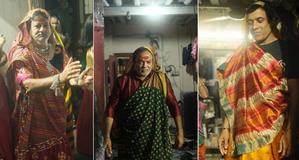
Why Men Dress Up As Women For Garba Performance In Ahmedabad
This age-old tradition symbolises penance, and a fascinating story of devotion and gender-bending customs passed down through generations. This ritual is more than just a dance; it is a deeply rooted tradition steeped in history, legend, and faith.
In this century-old custom, men dress up as women to atone for a curse placed on their ancestors by Sadu Mata, a woman whose story has been passed down through generations. According to local belief, over 200 years ago, a woman named Saduben sought protection from the men of the Barot community when a Mughal nobleman demanded her as a concubine.
Sadly, the men did not defend her, leading to the tragic loss of her child. In her grief and anger, Saduben cursed the men, declaring that their future generations would suffer as cowards, and committed 'sati'.
Sadu Mata Ni Pol, which houses over 1,000 residents, comes alive on the night of Ashtami. The pol, filled with narrow lanes and old-style homes, is a living relic of Ahmedabad's heritage. Crowds gather to witness men in sarees, twirling gracefully to the beats of Sheri Garba, a folk dance passed down through the generations.
A temple was erected to appease Sadu Mata's spirit and lift the curse. Every year, on the night of Ashtami, men from the community gather at Sadu Mata Ni Pol, don sarees, and perform Garba as an act of penance. This custom, still alive today, draws crowds from all over the city, curious to witness this powerful display of tradition and devotion.
While modern interpretations may associate the act of men dressing as women with bending gender norms, for the Barot community, it is a symbolic gesture of humility and respect. The ritual is believed to not only atone for the sins of the past but also to honour the blessings granted by Sadu Mata. Men who have prayed for personal wishes -- be it success in business, good health, or the birth of a child -- participate in this ritual to give thanks when their prayers are answered.
The Barot community of Gujarat is traditionally known for its role as genealogists, storytellers, and chroniclers for various communities. They particularly document family histories and preserve oral traditions. Historically, they served as keepers of genealogical records, especially for Rajput and Kshatriya families, and were integral to passing down cultural and religious stories through generations. In addition to their genealogical duties, they often performed during festivals, reciting epics and folk tales.
Though their traditional roles have evolved with time, the Barot community remains an important part of Gujarat's cultural heritage, particularly visible during festivals like Navratri, where their unique customs are still practiced.
One participant shared that he has been wearing a saree for the past five years to show gratitude to Sadu Mata. After wishing for prosperity in his business and the blessing of a son, he felt that the goddess had been kind to him. For him, this tradition serves as a meaningful connection to their roots, allowing the community to express thanks for the blessings they receive in their lives.
The tradition, however, isn't just about appeasing the curse. For many, it's about honouring the goddess they believe has protected and blessed their families for centuries. The pol transforms into a devotion site, with men of all ages paying homage to Sadu Mata, dressed in vibrant sarees, as an act of faith.
Ahmedabad, India's first UNESCO World Heritage City, is known for its rich history and traditions. The ritual of men performing Garba in sarees is just one of the many ways the city preserves its cultural heritage. Nestled among the 184 pols of the old city, Sadu Mata Ni Pol stands as a testament to the resilience and devotion of the Barot community.

Legal Disclaimer:
MENAFN provides the
information “as is” without warranty of any kind. We do not accept
any responsibility or liability for the accuracy, content, images,
videos, licenses, completeness, legality, or reliability of the information
contained in this article. If you have any complaints or copyright
issues related to this article, kindly contact the provider above.


















Comments
No comment